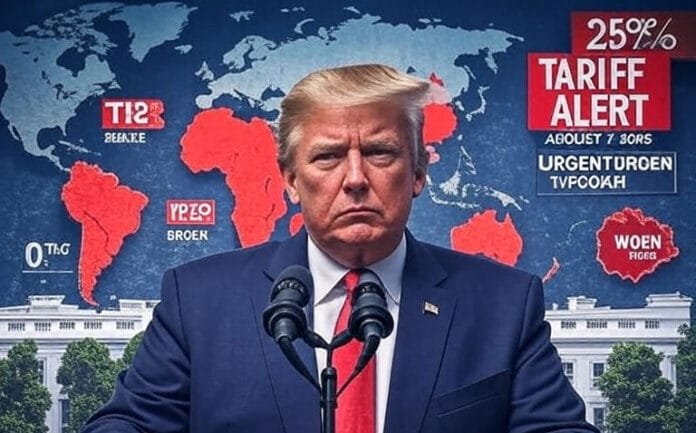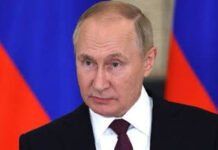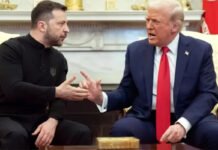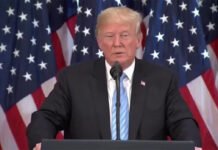The White House has officially released a comprehensive list of revised tariffs affecting nearly 70 countries worldwide, including a significant 25 percent tariff on India. This updated tariff framework, announced by President Donald Trump through an executive order titled “Further Revisions in Reciprocal Tariff Rates”, represents a pivotal move in the U.S. administration’s ongoing efforts to recalibrate global trade relationships and address perceived imbalances.
White House Postpones Tariff Implementation to August 7
Initially slated to come into effect on August 1, 2025, the new tariffs have been postponed by a week, now scheduled for enforcement starting August 7, 2025. This brief deferment applies not only to India but also to several other nations, allowing additional time for negotiations and potential last-minute adjustments in trade policies.
The postponement signals the White House’s intent to maintain flexibility amidst complex international trade dynamics while ensuring the imposition of tariffs remains a strategic tool for balancing economic interests and national security concerns.
President Trump Highlights the U.S.-India Trade Deficit and Tariff Disparities
President Trump emphasized the substantial trade deficit between the United States and India, asserting that India’s tariff barriers are among the highest globally. In his statement, he described India as a friend of the U.S., yet highlighted that bilateral trade volumes have remained relatively low over recent years, primarily due to India’s steep tariffs and stringent non-monetary trade restrictions.
“India is our friend, but in the last few years we have done relatively less trade with them because their tariffs are very high, the highest in the world,” Trump remarked.
This focus on tariff asymmetry underpins the administration’s rationale for imposing a 25 percent tariff on Indian goods, alongside additional fines related to India’s procurement of military equipment and energy resources from Russia.
Comprehensive Tariff Rates Across Multiple Countries
The executive order lays out a detailed list of tariff rates ranging from 10 to 40 percent, targeting various countries with tailored rates to address specific trade imbalances and security considerations. Key highlights from the list include:
India: 25% tariff plus additional fines
Japan: 15% tariff
Laos and Myanmar: 40% tariff
Sri Lanka: 20% tariff
United Kingdom: 10% tariff
Switzerland: 39% tariff
Syria: 41% tariff
These tariffs demonstrate the U.S. administration’s selective approach, prioritizing countries with notable trade deficits or where strategic concerns exist.
The Rationale Behind Tariff Revisions and Negotiations
The White House underscores that these tariffs are not arbitrary but part of a broader strategy to incentivize trade and security agreements with partner nations. President Trump noted ongoing negotiations with many countries and expressed optimism that some will soon formalize agreements that reduce trade barriers and foster closer cooperation on economic and national security issues.
However, the executive order also stresses that several partners have proposed terms considered insufficient by the U.S., failing to adequately address trade imbalances or align with American security priorities. This justifies the continued application and revision of tariffs until mutually beneficial agreements are reached.
Impact on India: Economic and Strategic Dimensions
India faces a substantial 25 percent tariff on selected imports into the United States, which will inevitably impact bilateral trade flows. This tariff increase is paired with additional fines related to India’s defense and energy dealings with Russia — a notable aspect highlighting geopolitical tensions influencing trade policy.
Given the scale of the U.S.-India trade relationship, these tariffs may ripple through various sectors, from pharmaceuticals and textiles to automobiles and technology products. Indian exporters could experience increased costs, potentially reducing their competitiveness in the U.S. market.
Moreover, the tariffs reflect a broader U.S. strategy to nudge India towards alignment with American geopolitical interests, especially amid ongoing tensions surrounding Russia’s global posture.
Overview of Tariff Rates by Country
The executive order provides granular details on tariff rates for approximately 70 countries. Below is a summarized selection illustrating the spectrum of tariffs and their potential trade impact:
| Country | Tariff Rate |
|---|---|
| Afghanistan | 15% |
| Algeria | 30% |
| Bangladesh | 20% |
| Brazil | 10% |
| Cambodia | 19% |
| Indonesia | 19% |
| Iraq | 35% |
| Israel | 15% |
| Kazakhstan | 25% |
| Malaysia | 19% |
| Myanmar | 40% |
| Nigeria | 15% |
| Pakistan | 19% |
| Serbia | 35% |
| South Africa | 30% |
| South Korea | 15% |
| Taiwan | 20% |
| Thailand | 19% |
| Turkey | 15% |
| United Kingdom | 10% |
| Vietnam | 20% |
This spectrum highlights a calibrated approach, focusing higher tariffs on countries with notable trade imbalances or geopolitical issues, while applying moderate rates to others.
Special Tariff Provisions for the European Union
An important nuance in the executive order addresses tariffs on goods imported from the European Union (EU). Items classified under column 1 of the duty schedule with a rate below 1 percent will face zero tariffs, while those with rates exceeding 15 percent will be capped at a 15 percent tariff.
This tailored provision reflects a more measured stance toward the EU, recognizing existing trade frameworks while addressing specific tariff concerns.
Looking Ahead: Trade Negotiations and Global Economic Implications
The announcement of these revised tariffs and the accompanying delay in their implementation underscore the complex and evolving nature of global trade under the current U.S. administration. The tariffs not only aim to redress trade imbalances but also serve as a lever to compel strategic cooperation on economic and security fronts.
For India and other affected countries, these measures signal a call to intensify trade negotiations and potentially recalibrate policies to foster more balanced and mutually beneficial trade relations with the U.S.
Global markets and businesses must now brace for the tangible effects of these tariffs, which may reshape supply chains, pricing strategies, and international trade alliances in the coming months.
Conclusion: Trump Tariffs Mark a New Chapter in U.S. Trade Policy
The White House’s release of the updated tariff list—including the significant 25 percent tariff on India—and the brief postponement in enforcement, marks a strategic effort by the Trump administration to assert greater control over trade dynamics and address perceived unfair practices.
By combining tariffs with security-related fines, particularly targeting India’s dealings with Russia, the U.S. signals a fusion of economic policy and geopolitical strategy. These measures reinforce America’s determination to correct trade imbalances and protect national interests.
As these tariffs come into force on August 7, 2025, the global trade landscape will witness renewed volatility and opportunities for negotiation. The unfolding developments will be closely watched by international trade partners, policymakers, and industry leaders worldwide.
















